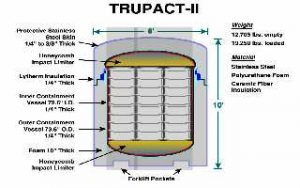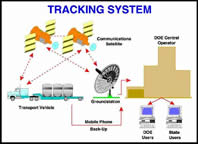Program Summary
Introduction
The Waste Isolation Pilot Plant (WIPP), the nation’s repository for “defense-related” transuranic wastes, received its first shipment of non-mixed transuranic waste on March 26, 1999. The shipment was made from Los Alamos National Laboratory. As other generator sites become certified, wastes generated from research, development and production of nuclear weapons at DOE sites across the country will be shipped to WIPP, 26 miles southeast of Carlsbad, New Mexico. A campaign of approximately 38,000 shipments is expected to continue for over 35 years.
The State of New Mexico has been working since 1989, internally and with a coalition of western states through the Western Governors’ Association, to develop a transportation system whose goal is the safe and uneventful transport of radioactive materials through western states. The WIPP Transportation Safety Program is a cooperative effort among the shipment-corridor states, tribes, local officials and the DOE. The program goes beyond what is required by law and has been proven through actual use in other radioactive waste shipping campaigns. There is not a shipment on the road that will have undergone as much scrutiny by transportation safety specialists as WIPP shipments. In a July 1989 report, the prestigious National Academy of Sciences WIPP Panel said, “The system proposed for transportation of TRU waste to WIPP is safer than that employed for any other hazardous material in the United States today and will reduce risk to very low levels.”
Why all the fuss?
The wastes being shipped to the repository in Carlsbad are not harmless. Transuranic wastes include laboratory clothing, tools, plastics, rubber gloves, wood, metals, glassware and solidified waste contaminated with man-made radioactive materials including plutonium, americium and curium. Some of these wastes, known as “mixed” transuranic waste, also contain hazardous chemical constituents. Most of these wastes are “contact-handled,” meaning the radiation they emit does not require heavy lead shielding. The primary radiation hazard posed by this waste is through inhalation or ingestion. Inhalation of certain transuranic materials, such as plutonium, even in very small quantities, could deliver significant internal radiation doses. The remaining waste is referred to as “remote-handled” because it requires heavy shielding and presents a much more significant external radiation hazard than contact-handled waste.
How are transuranic wastes being shipped?
 The TRUPACT-II underwent full-scale testing to demonstrate its ability to survive crashes. |
All contact-handled transuranic wastes destined for WIPP are transported in the Transuranic Packaging Transporter (TRUPACT-II), a buttonreusable shipping package or “cask,” certified by the Nuclear Regulatory Commission (NRC). Full-scale TRUPACT-II prototypes were subjected to a series of tests to demonstrate their ability to survive severe crashes and punctures followed by fires or immersion in water. Tests of full-scale TRUPACT-II containers went well beyond the NRC regulations, which require only computer simulation or tests on scale models. The TRUPACT-II has a flexible design which allows surfaces to move but still survive major deformities without leaking.
 No more than three TRUPACTs, each holding up to fourteen 55-gallon drums of waste, are secured directly to specially designed trailers and pulled by conventional diesel-powered tractors. The trucks are equipped with a satellite communication and tracking system called TRANSCOM.
No more than three TRUPACTs, each holding up to fourteen 55-gallon drums of waste, are secured directly to specially designed trailers and pulled by conventional diesel-powered tractors. The trucks are equipped with a satellite communication and tracking system called TRANSCOM.
About five percent of WIPP-bound waste by volume is classified as remote-handled. Additional procedures and standards will be required to address transportation safety related to these shipments, including certification of a shipping container by NRC.
What routes are used?
Specific routes have been identified for all WIPP shipments. The State of New Mexico has designated the following routes in accordance with federal regulations and guidelines:
- Shipments from the north enter New Mexico on I-25 at Raton, travel south to the intersection of U.S. 285 (Lamy cutoff), and continue south on U.S. 285 through Vaughn and Roswell to the Carlsbad bypass, then east on U.S. 62/180 to WIPP.
- Shipments from the Los Alamos National Laboratory (TA-54) use NM 4 to NM 502, then east to U.S. 84/285 (at Pojoaque) and continue south on U.S. 84/285 to the relief route (NM 599), then north on I-25 to U.S. 285 and south to Carlsbad and WIPP.
- Shipments from the west enter the State on I-40 near Gallup, travel east through Grants, Albuquerque and at Clines Corners turn south on U.S. 285 through Carlsbad to WIPP.
- Shipments from the east enter New Mexico from the south on U.S. 285 at the Texas/New Mexico border, travel north through Loving to Carlsbad and then to WIPP. The I-40 route from the Texas border west to Clines Corners is also a designated for shipments from the east, but DOE is currently only uses the southern route.
WIPP shipments cannot deviate from designated routes without explicit permission from the state
What is New Mexico doing to prevent accidents?
Most truck accidents can be avoided by alert, skilled drivers who avoid driving when road and weather conditions are particularly hazardous and use high-quality, well-maintained equipment. These preventative measures were used in developing the accident prevention portion of the program to reduce the risks associated with transporting hazardous materials.
Drivers & Carriers. The U.S. Department of Transportation sets standards for drivers of trucks that carry hazardous cargo. DOE agreed to go beyond these requirements for its WIPP drivers and carrier. DOE has contracted with exclusive carriers whose drivers have extensive, accident-free experience. WIPP drivers are subject to unannounced drug testing; will have no financial incentive to speed; and are fired upon any moving violation, even in their personal vehicles. The states have a program to audit the shipping contractors for compliance with the vehicle and driver requirements.
Independent Inspections. To identify and correct any mechanical defects in the vehicle and ensure radiation levels are within allowable limits, all shipments are subject to multiple inspections by state officials using enhanced safety standards that are much more stringent than those for other hazardous materials shipments. Inspections by specially trained state inspectors from the Motor Transportation Division will take place prior to departure from the generator site, upon entry into New Mexico, and when the shipment reaches the WIPP site. In addition, in compliance with their contract with DOE, drivers will pull over approximately every two hours to conduct a mechanical inspection of the vehicle.
Bad Weather and Road Conditions. The states and DOE have agreed on procedures to monitor weather and road conditions so that shipments can avoid hazards. Shipments will not depart DOE facilities if they are likely to encounter severe weather along the route. If unexpected bad weather or road conditions are encountered, procedures for the selection and use of safe parking areas have been developed.
 Shipment Notification and Tracking. All transuranic waste shipments are buttonmonitored and tracked through a satellite-based system called TRANSCOM. The State of New Mexico has direct access to this system, which provides shipping schedules and real-time tracking of shipments on the road. TRANSCOM allows for two-way communications with drivers and immediate emergency response guidance information, if necessary. In addition, the drivers have cellular and satellite telephones, as well as CB radios, that can be used in the event of an emergency.
Shipment Notification and Tracking. All transuranic waste shipments are buttonmonitored and tracked through a satellite-based system called TRANSCOM. The State of New Mexico has direct access to this system, which provides shipping schedules and real-time tracking of shipments on the road. TRANSCOM allows for two-way communications with drivers and immediate emergency response guidance information, if necessary. In addition, the drivers have cellular and satellite telephones, as well as CB radios, that can be used in the event of an emergency.
What is New Mexico doing to prepare for transportation incidents?
Emergency preparedness is a significant part of the WIPP Transportation Safety Program. While the shipments are conducted in such a way as to prevent accidents from occurring, if one does take place, the State will be prepared to respond quickly, safely and effectively.
Emergency Response Plans and Procedures. A well organized and coordinated effort is necessary to make response to an accident swift and effective. Plans and procedures specifically designed to deal with transportation incidents involving the WIPP shipments are in place. The State of New Mexico has prepared several guidance documents which specify notification, incident command, and response procedures for use in the event of a WIPP accident.
Mutual Aid Agreements. The State of New Mexico has developed written agreements with DOE and the states of Arizona, California, Colorado, Nevada, and Utah to enhance any response to a WIPP accident, as well as to provide assistance for across state borders.
Training, Drills & Exercises. In coordination with DOE, the State of New Mexico has developed a WIPP-specific training regimen for emergency responders, which is incorporated directly into hazardous materials training programs for fire fighters, police and emergency medical staff along the routes. Hospital emergency room personnel also have been trained. Drills and exercises supplement the training.
Emergency Response Equipment. Radiation detection and personal protection equipment has been provided to emergency responders along the initial planned shipping routes in New Mexico. Responders have been trained to properly use this equipment in the event of an incident involving a TRUPACT.
